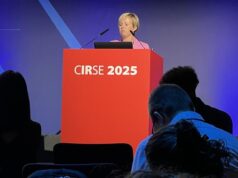
A prospective randomised controlled study that compared outcomes between hepatocellular carcinoma patients who were treated by microwave ablation with those who were treated by radiofrequency ablation, did not find a benefit for microwave over radiofrequency.
For local tumour progression and survival at two-year follow-up, “the theoretical benefit of microwave does not translate into clinical benefit for hepatocellular patients with lesions smaller than 4cm. This was a negative trial as microwave failed to demonstrate superiority over radiofrequency,” said Alban Denys, Radiology, Lausanne University Hospital, Lausanne, Switzerland, who presented the results at CIRSE 2017.
Denys reported that this was a prospective, randomised, multicentre study to compare the efficacy of radiofrequency ablation with microwave ablation. The theoretical advantages of microwave include shorter ablation time, higher temperature of ablation, reduction of heat-sink effect and treatment of larger lesions. Previous modelling studies have predicted that microwave ablation is likely to be more effective than radiofrequency ablation, particularly when they are in the proximity of large vessels, where radiofrequency is widely thought to be compromised by the heat sink effect.
“It has also been claimed that the recurrence we observe with radiofrequency around the vasculature of the liver, mainly large vessels, should be reduced with microwave. However, it has not been proven in vivo that one technique is superior to the other,” he added. Denys also noted that a previous study from China that compared these modalities (in which a non-commercial device was used) did not show a benefit for microwave over radiofrequency.
“We found no difference in local tumour progression and survival at two-year follow-up between patients who were treated by radiofrequency ablation when compared to those treated with microwave ablation,” Denys reported.
From 2011 to 2015, the investigators randomised patients with hepatocellular carcinoma who had three, or fewer, lesions that were four centimetres in length or shorter, to treatment with either radiofrequency ablation or microwave ablation. All the patients had chronic liver disease; were unsuitable for surgery; and eligible for thermoablative treatment. The primary outcome was the rate of local tumour progression at two-year follow-up. Secondary outcomes were time to progression; survival; incomplete treatment rate; and safety of the treatment. The investigators used the unpaired T-test and Chi-square test depending of the type of data. They analysed survival using Kaplan-Meier curves.
Final data were analysed from 73 patients (15% female, 73% Child–Pugh A, 104 lesions treated) in the radiofrequency ablation group and 72 patients (17% female, 80% Child–Pugh A, 98 lesions treated) in the microwave ablation group the two patient groups were similar for demographic, biology and tumour characteristics (mean lesion size was 18mm in both groups).
Results
At the two-year mark, there were slightly higher numbers of recurrence in the radiofrequency ablation group, ie, just over 11% cases of local tumour progression, compared to 6% in the microwave ablation group (p=0.32). The average time to local progression in the radiofrequency ablation group was 16 months (6.5 months standard deviation [SD]); in the microwave ablation group, it was 12 months (8.2 SD; p=0.28) This showed, said Denys, that there was late recurrence in the radiofrequency group, for unknown reasons.
The survival rate at two-year follow-up was described as “excellent” in both groups—87% in the radiofrequency ablation group and 88% in the microwave ablation group (p=0.78). The rate of incomplete treatment after one session of thermoablation was similar in the two groups (4% and 5%, respectively; p=0.93).
There were fewer complications in the microwave group, and no major complications in either group. There were two grade four complications—both arterial bleeds that required embolization—in the microwave ablation group. Nearly the same number of patients in both groups went on to have a transplantation.











I find nothing new in the prospective randomized controlled study presented by Prof. Alban Denys at CIRSE 2017. Indeed, it seems to me that some of the statements “in quote” could be misleading for a not expert or distracted reader.
It should be noted that, according to the Arrhenius Law, for the same size and volume of the ablation that surrounds the tumor with an adequate margin, the clinical benefits must be the same independently from the RF or MW process adopted to produce it.
From a practical point of view a correct and unbiased criterion for the comparison of the two processes should be done on the basis of two parameters: thermal efficiency and efficacy.
Thermal efficiency depends on the technological solutions adopted, such as the presence or absence of the cooling system and influences the maximum ablation dimension practically obtainable in a reasonable time.
Conversely the efficacy depends essentially on how the ablative procedure is performed (single needle or multiple needles, single insertion or sequential insertions, correctness of the track ablation etc.). The efficacy of the treatment, which is strongly influenced by blood perfusion, obviously affects long-term prognosis, tumor inactivation ability, progression, survival rate and rate of incomplete treatment.
It is well know that the thermal efficiency of MWs is very high, allowing higher ablation temperatures in shorter time.
Unfortunately the lowest thermal efficiency of the RF procedure effectively limits the maximum size of the ablation obtainable with a single needle and this explains while in the past multi-needle RF systems have been proposed. Such systems have not found widespread use because in the meantime the technology of MW has made a very rapid progress. Currently the most advanced MW systems, based on multi-needle cooled or uncooled technology, have a greater flexibility of use with respect to the RF systems and allow to treat even large tumors regardless of the affected organ.
Guido Biffi Gentili
[email protected]
Professor of Applied Electromagnetics
Information Engineering Dept.
University of Florence